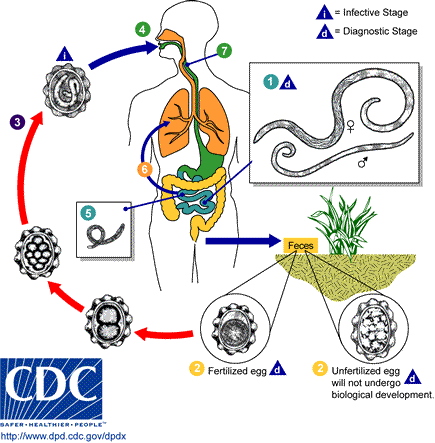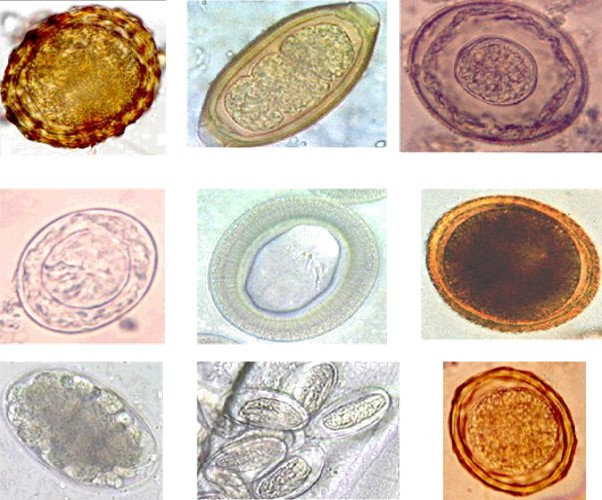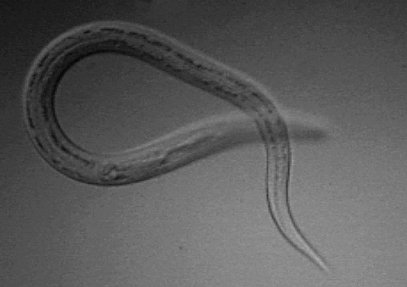|
Whipworm
''Trichuris trichiura, Trichocephalus trichiuris'' or whipworm, is a parasitic roundworm (a type of helminth) that causes trichuriasis (a type of helminthiasis which is one of the neglected tropical diseases) when it infects a human large intestine. It is commonly known as the ''whipworm'' which refers to the shape of the worm; it looks like a whip with wider "handles" at the posterior end. The helminth is also known to cause rectal prolapse. Life cycle The female ''T. trichiura'' produces 2,000–10,000 single-celled eggs per day. Eggs are deposited from human feces to soil where, after two to three weeks, they become embryonated and enter the "infective" stage. These embryonated infective eggs are ingested by hand-mouth or through fomites and hatch in the human small intestine, exploiting the intestinal microflora as a stimulus to hatching. This is the location of growth and molting. The infective larvae penetrate the villi and continue to develop in the small intestine. T ... [...More Info...] [...Related Items...] OR: [Wikipedia] [Google] [Baidu] |
Trichuris Trichiura Eggs, Including HE Stain
''Trichuris'' (synonym ''Trichocephalus''), often referred to as whipworms or the silent serpent (which typically refers to ''T. trichiura'' only in medicine, and to any other species in veterinary medicine), is a genus of parasitic helminths from the roundworm family Trichuridae. The name whipworm refers to the shape of the worm; they look like whips with wider "handles" at the posterior end. Species The genus ''Trichuris'' includes over 70 species, which infect the large intestine of their host, including: * ''Trichuris trichiura'' (sometimes ''Trichocephalus trichiurus'') – causes trichuriasis in humans * ''Trichuris campanula'' (cat whipworm) * '' Trichuris serrata'' (cat whipworm) * ''Trichuris suis'' (pig whipworm) * ''Trichuris muris'' (mouse whipworm) * '' Trichuris vulpis'' (dog whipworm) A new species – as yet unnamed – has been identified in François’ leaf monkey ('' Trachypithecus francoisi''). Other species in this genus include ''Trichuris cynocephalus'' ... [...More Info...] [...Related Items...] OR: [Wikipedia] [Google] [Baidu] |
Trichuriasis
Trichuriasis, also known as whipworm infection, is an infection by the parasitic worm '' Trichuris trichiura'' (whipworm). If the infection is only with a few worms, there are often no symptoms. In those who are infected with many worms, there may be abdominal pain, fatigue and diarrhea. The diarrhea sometimes contains blood. Infections in children may cause poor intellectual and physical development. Low red blood cell levels may occur due to loss of blood. The disease usually spreads when people eat food or drink water containing these worms' eggs. This may occur when contaminated vegetables are not fully cleaned or cooked. Often these eggs are in the soil in areas where people defecate outside and where untreated human feces is used as fertilizer. These eggs originate from the feces of infected people. Young children playing in such soil and putting their hands in their mouths also become infected easily. The worms live in the large bowel and are about four centimetres in ... [...More Info...] [...Related Items...] OR: [Wikipedia] [Google] [Baidu] |
Rectal Prolapse
A rectal prolapse occurs when walls of the rectum have prolapsed to such a degree that they protrude out of the anus and are visible outside the body. However, most researchers agree that there are 3 to 5 different types of rectal prolapse, depending on whether the prolapsed section is visible externally, and whether the full or only partial thickness of the rectal wall is involved. Rectal prolapse may occur without any symptoms, but depending upon the nature of the prolapse there may be mucous discharge (mucus coming from the anus), rectal bleeding, degrees of fecal incontinence, and obstructed defecation symptoms. Rectal prolapse is generally more common in elderly women, although it may occur at any age and in either sex. It is very rarely life-threatening, but the symptoms can be debilitating if left untreated. Most external prolapse cases can be treated successfully, often with a surgical procedure. Internal prolapses are traditionally harder to treat and surgery may not b ... [...More Info...] [...Related Items...] OR: [Wikipedia] [Google] [Baidu] |
Helminthiasis
Helminthiasis, also known as worm infection, is any macroparasite, macroparasitic disease of humans and other animals in which a part of the body is infected with parasitism, parasitic worms, known as helminths. There are numerous species of these parasites, which are broadly classified into cestoda, tapeworms, trematoda, flukes, and nematode, roundworms. They often live in the gastrointestinal tract of their host (biology), hosts, but they may also burrow into other organ (anatomy), organs, where they induce physiological damage. Soil-transmitted helminthiasis and schistosomiasis are the most important helminthiases, and are among the neglected tropical diseases. These group of helminthiases have been targeted under the joint action of the world's leading pharmaceutical industry, pharmaceutical companies and non-governmental organizations through a project launched in 2012 called the London Declaration on Neglected Tropical Diseases, which aimed to control or eradicate certain n ... [...More Info...] [...Related Items...] OR: [Wikipedia] [Google] [Baidu] |
Helminth
Parasitic worms, also known as helminths, are a polyphyletic group of large macroparasites; adults can generally be seen with the naked eye. Many are intestinal worms that are soil-transmitted and infect the gastrointestinal tract. Other parasitic worms such as schistosomes reside in blood vessels. Some parasitic worms, including leeches and monogeneans, are ectoparasites thus, they are not classified as helminths, which are endoparasites. Parasitic worms live in and feed in living hosts. They receive nourishment and protection while disrupting their hosts' ability to absorb nutrients. This can cause weakness and disease in the host, and poses a global health and economic problem. Parasitic worms cannot reproduce entirely within their host's body; they have a life cycle that includes some stages that need to take place outside of the host. Helminths are able to survive in their mammalian hosts for many years due to their ability to manipulate the host's immune respon ... [...More Info...] [...Related Items...] OR: [Wikipedia] [Google] [Baidu] |
Soil-transmitted Helminth
The soil-transmitted helminths (also called geohelminths) are a group of intestinal parasites belonging to the phylum Nematoda that are transmitted primarily through contaminated soil. They are so called because they have a direct life cycle which requires no intermediate hosts or vectors, and the parasitic infection occurs through faecal contamination of soil, foodstuffs and water supplies. The adult forms are essentially parasites of humans, causing soil-transmitted helminthiasis (STH), but also infect domesticated mammals. The juveniles are the infective forms and they undergo tissue-migratory stages during which they invade vital organs such as lungs and liver. Thus the disease manifestations can be both local and systemic. The geohelminths together present an enormous infection burden on humanity, amounting to 135,000 deaths every year, and persistent infection of more than two billion people. Species Soil-transmitted helminths are typically from the following families ... [...More Info...] [...Related Items...] OR: [Wikipedia] [Google] [Baidu] |
Albendazole
Albendazole is a broad-spectrum antihelmintic and antiprotozoal agent of the benzimidazole type. It is used for the treatment of a variety of intestinal parasite infections, including ascariasis, pinworm infection, hookworm infection, trichuriasis, strongyloidiasis, taeniasis, clonorchiasis, opisthorchiasis, cutaneous larva migrans, giardiasis, and gnathostomiasis, among other diseases. Common side effects include nausea, abdominal pain, and headache. Rare but potentially serious side effects include bone marrow suppression which usually improves on discontinuing the medication. Hepatitis, Liver inflammation has been reported and those with prior liver problems are at greater risk. It is pregnancy category D in Australia, meaning it may cause harm if taken by pregnant women. Albendazole was developed in 1975. It is on the WHO Model List of Essential Medicines, World Health Organization's List of Essential Medicines. Albendazole is available in a fixed-dose combination with ... [...More Info...] [...Related Items...] OR: [Wikipedia] [Google] [Baidu] |
Hookworm
Hookworms are Gastrointestinal tract, intestinal, Hematophagy, blood-feeding, parasitic Nematode, roundworms that cause types of infection known as helminthiases. Hookworm infection is found in many parts of the world, and is common in areas with poor access to adequate water, sanitation, and hygiene. In humans, infections are caused by two main species of roundworm, belonging to the genera ''Ancylostoma'' and ''Necator (nematode), Necator''. In other animals the main parasites are species of ''Ancylostoma''. Hookworm is closely associated with poverty because it is most often found in impoverished areas, and its symptoms promote poverty through the educational and health effects it has on children. It is the leading cause of anemia and undernutrition in developing countries, while being one of the most commonly occurring diseases among poor people. Hookworm thrives in areas where rainfall is sufficient and keeps the soil from drying out, and where temperatures are higher, making r ... [...More Info...] [...Related Items...] OR: [Wikipedia] [Google] [Baidu] |
Ascaris Lumbricoides
''Ascaris lumbricoides'' is a large parasitic worm, parasitic Nematoda, roundworm of the genus ''Ascaris.'' It is the most common parasitic worm in humans. An estimated 807 million–1.2 billion people are infected with ''Ascaris lumbricoides'' worldwide. People living in tropics, tropical and subtropics, subtropical countries are at greater risk of infection. Infection by ''Ascaris lumbricoides'' is known as ascariasis. It has been proposed that ''Ascaris lumbricoides'' and ''Ascaris suum'' (pig roundworm) are the same species. Life cycle ''Ascaris lumbricoides'', a roundworm, infects humans via the fecal-oral route. Eggs released by adult females are shed in feces. Unfertilized eggs are often observed in fecal samples but never become infective. Fertilized eggs embryonate and become infectious after 18 days to several weeks in soil, depending on the environmental conditions (optimum: moist, warm, shaded soil).Parasites - Ascariasis. (14 February 2018). Retrieved from https:/ ... [...More Info...] [...Related Items...] OR: [Wikipedia] [Google] [Baidu] |
Cross-section Of Whipworm On Microscopy
Cross section may refer to: * Cross section (geometry) ** Cross-sectional views in architecture and engineering 3D *Cross section (geology) * Cross section (electronics) * Radar cross section, measure of detectability * Cross section (physics) **Absorption cross section **Nuclear cross section **Neutron cross section **Photoionisation cross section **Gamma ray cross section * ''Cross Section'' (album), 1956 musical album by Billy Taylor See also *Cross section (fiber), microscopic view of textile fibers. *Section (fiber bundle), in differential and algebraic geometry and topology, a section of a fiber bundle or sheaf *Cross-sectional data, in statistics, econometrics, and medical research, a data set drawn from a single point in time **Cross-sectional study, a scientific investigation utilizing cross-sectional data ***Cross-sectional regression In statistics and econometrics, a cross-sectional regression is a type of Regression analysis, regression in which the Dependent and in ... [...More Info...] [...Related Items...] OR: [Wikipedia] [Google] [Baidu] |





